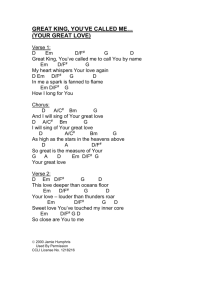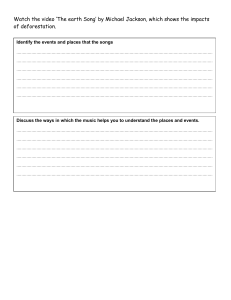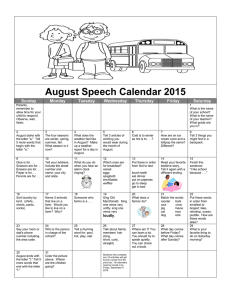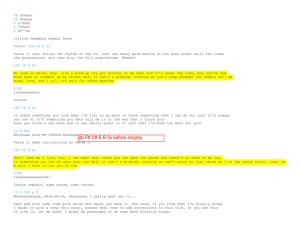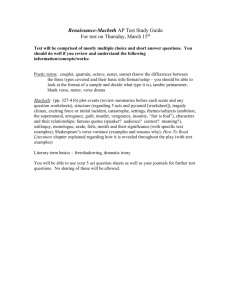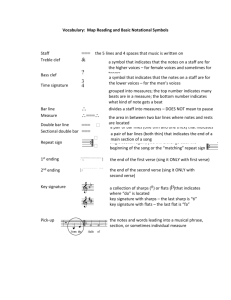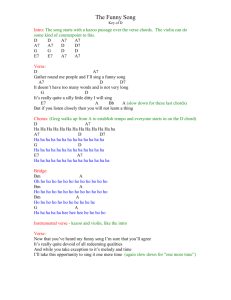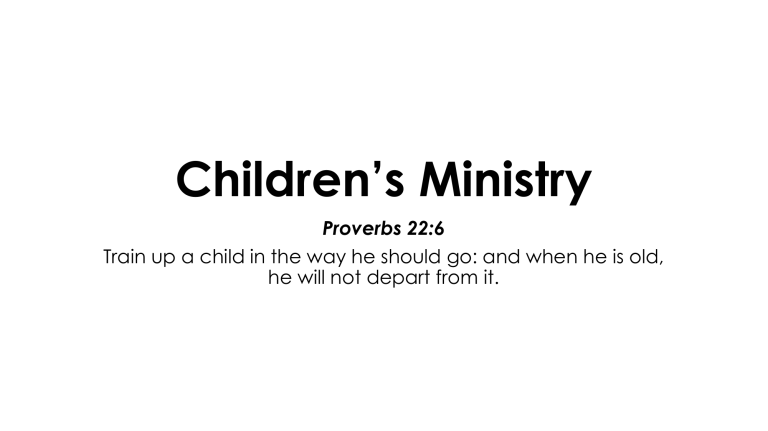
Children’s Ministry Proverbs 22:6 Train up a child in the way he should go: and when he is old, he will not depart from it. Importance of Program Parts ○ Prayer: ● To dedicate the program to God. ● To open the hearts and minds of everyone. ● To ask for the free course of the Holy Spirit. ● To ask for the power of the Holy Spirit. ○ Songs: ● To praise God in Song. ● To energize and weary down the children. ● To learn truths through song. ○ Game or Activity: ● To weary down the children. ● To teach a lesson in a fun way. ● To get the children to focus on the lesson due to being wearied down. ○ Story: ● To exemplify the lesson. ● To preach to the children. ● To get their attention. ○ Verse: ● To emphasize and solidify the truth. ● To place the focus on the Bible. ○ Object Lesson: ● To illustrate the verse. ● To visualize the verse. ● To apply the verse. ○ Theme: ● The overarching idea and trajectory of the lesson. ● It needs to be emphasized and present in all parts of the program. ● The unified thought of the program. ● Makes the program coherent. Dos and Don’ts Outside of the Program ○ Dos: ● Be a part of the Program. ● Participate in singing, verse, activity or game. ● Keep the children behave. ● Always think of a way to support the leader: 1. Hold the props. 2. Giving our prizes or food. 3. Help facilitate games or play with them. 4. Assist the children. ● Learn the children's name. ● Spread out ● Keep their attention on the program. ● Follow the leader. ○ Don'ts: ● Don't be a part of the noise. ● Don't use your phone, eat, or talk to anyone inside or outside the program. ● Don't let the children make noise or disturb someone. ● Don't leave the program area. ● Don't let the leader do the noise control and take charge. ● Don't let the children take control. ● Don't catch the children's attention if you are not the leader. Dos and Don’ts Inside of the Program Dos: ● Sing and recite loudly for all to hear. ● Sing and speak clearly. ● Bring your Bible. ● Explain, emphasize, and take time on the point. ● Speak Tagalog only and translate English Words to Tagalog. ● Make the children repeat the prayer. ● Memorize the verse. ● Think what you will say. ● Get the children's attention. ● Use hand gestures and proper position. ○ Don'ts: ● Don't stray away from the theme or point ● Don't spend too much time chatting. ● Don't talk with the children during the program. ● Don't say unnecessary things. ● Don't mumble. ● Don't block the props or other leaders. Children’ Worker Training Preliminaries ○ What is your goal? ● To fulfill the great commission: 1. Win them 2. Baptize them 3. Teach the saved that they may grow and become productive Christians. ○ Who are you teaching? ● Age Group: Children ● Gender: Boy and Girl ● Unchurched: Bible Basics (Psalm 111:6) ● Churched: Application (James 1:22) ● Other Backgrounds and Teachings: Truth (John 8:32) ○ What are their needs? ● Love ● Instructions ● Compassion ● Example ● Acceptance ● Guidance ● Forgiveness ● Doctrine ● Fellowship ● Food and Drinks ● Clothing ○ How to be effectively use the short time? ● Teach by Themes. One principle taught with in different methods. ● Multiply by dividing and delegation. ● Be early. ● Plan for everything and for every moment. Program Methods Practice! Practice! Practice! ○ Themes: ● The overarching idea and trajectory of the lesson. ● It needs to be emphasized and present in all parts of the program. ● The unified thought of the program. ● Makes the program coherent. ● The basis of all the program parts. ● By the end of the lesson, the children should have learned what the theme. ○ Songs: ● Sing loud and clear. ● Sing in tune. ● Sing energetically. ● Add actions if possible. ● All must participate. ● The song must be easy to sing and catchy. ● Should be meaningful. ● Must always have visual aids. ● Add accompaniment if possible. ● Explain the song after singing. ● Sing Tagalog Songs or Translate English Songs. ● The Three Song Combination: 1. Energetic Song 2. Story Song 3. Theme Song ○ Game: ● Relate it to the Theme and explain its significance. ● Make sure it is fun and easy to play. ● Always include everyone. ● Explain the game clearly. ● Have all the teachers facilitate the children and control the crowd. ● Be the most energetic. ● Give out prizes after the game. ● Settle everyone down before explaining the game. ○ Activity: ● It must be fun and meaningful ● Explain the activity properly and clearly. ● Have the teachers facilitate. ● Provide a table if possible. ● Lay out cloths on the floor and sit there together. ● Have variations of activities. ● Must be related to the theme. ● Explain the significance to the theme. ○ Bible Lesson: ● Read the story plenty of times before telling it. ● Understand the story and note important points. ● Speak loud and clear. ● Use hand gestures and move around. ● Be emotional. ● Use words children will understand. Speak Tagalog. ● Always use visual aids. ● Employ a variation in story telling. ● Catch the children’s attention always. ● Talk to the children and ask questions. Allow them to participate. ● Explain the meaning of the story after the story. ● Don’t be shy. ○ Verses: ● Speak loud and clear. ● Visualize the Verse and make it readable. ● Vary the method of teaching. ● Explain unfamiliar words. ● Teach proper pronunciation. ● Add actions or gestures if possible. ● Explain the verse correctly. ● Translate to Tagalog. ● Mention an application and personal experience. ● Make it fun through drills and activities. ● Say the reference before and after the verse. ● Employ various fun methods of memorization. ○ Object Lesson: ● Speak loud and clear. ● Visualize the Verse through the Object Lesson. ● Vary the method of teaching. ● Explain its significance. ● Make it interesting and exciting. ● Make sure it is easy to understand and is relatable. ● Explain it properly. ● Be creative. ● Repeat the verse always throughout the object lesson. Collection ○ Themes: ● ○ Songs: ● ○ Games: ● ○ Activities: ● ○ Bible Lessons: ● ○ Verses: ● ○ Object Lesson: ●
